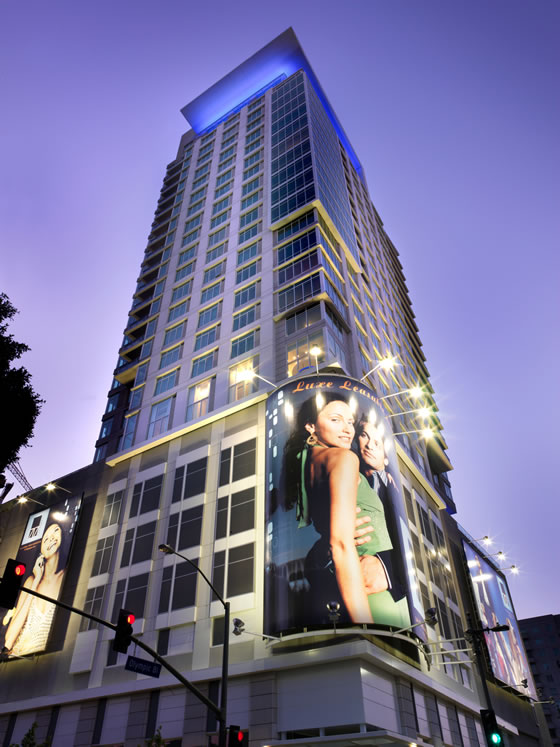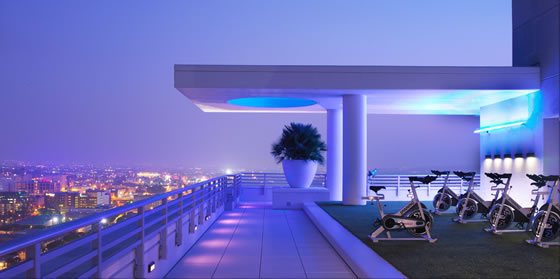Tenants living in residential high-rises have different security expectations based on a wide variety of factors, says Daun St. Amand, vice president at RTKL Associates. “They ebb and flow relative to several things.”
Security levels and expectations vary based on the type of residential high-rise: market-rate apartment buildings vs. high-end branded environments. Particularly in the luxury range, security is critical (and often a selling point) for tenants. The pricier the building, the more often you’ll find a heavy investment in security technology. “Especially when we’re talking about celebrity types,” says Amand, “they want to get in and out of their building without being seen – unless they want to be seen.” These high-rises provide protection from intruders and unwelcome guests, but also provide tenants with privacy.

717 Olympic in Los Angeles stands at 26 stories tall and fills a niche for upscale housing in the city center. The tower integrates secure access points that don’t interfere with the look and feel of the building. Photo by Edward LaCasse
“Security is also highly dependent on the subjective views of the residents,” says Chris Grniet, regional managing director for Guidepost’s TechnologyDesign Consulting team, “whether it’s the location they’re in, or what their exposure has been to crimes in that particular area.”
Grniet says that nationally publicized incidents, even if they take place in completely a different building type, raise everyone’s awareness. “What’s secure and what isn’t for residential properties tends to wax and wane with the perception of general security and safety in the overall environment.”
Security Isn’t Always Created Equal
When Amand talks about security in residential high-rises, he often refers to “rings.” Each ring incorporates a different level or layer of technology and sophistication, depending on the building and when it was constructed or renovated.
“We follow five concentric rings of security,” Amand explains. “All five rings are typically found in very high-end, luxury environments. Then we take out rings as we get down to market-rate apartments.”
The first ring of security typically occurs at the first point of entrance or the boundary of the property: a gated community, a security guard, etc. Additional rings or layers of protection are provided as you move through the building toward living quarters.
The second ring of security occurs at the lobby door, where tenants or visitors are greeted by a concierge or another security guard.

Daun St. Amand, vice president at RTKL Associates, says he has learned the value of personnel in residential high-rise security. Professional staff members add to the level of comfort and security tenants feel when they come home.
Private elevating makes up the third ring of security, which requires tenants to use a card key or provide a thumbprint or retina scan to gain access to their floor. The elevator takes them to their floor, but opens into a private atrium area, which serves as the fourth ring of security. “If someone is riding in the elevator with you, then they’re not entering directly into your unit,” explains Amand.
The fifth ring is very exclusive, and there aren’t many U.S. buildings that incorporate this security layer. In several of RTKL’s high-end international projects, Amand says tenants don’t live in the unit year-round. Because service personnel and building stuff might be coming in and out of the unit, the tenant may want to remotely monitor the unit. “We have one 12-story building in the United States we’re looking at right now that’s considering this level of security,” says Amand. “But it’s not common.”
Most market-rate residential high-rises incorporate the first three layers of security.
Discrete Design
Multifamily high-rises can be hard to classify. Are they residential? Are they commercial? According to Grniet, residential high-rises fall somewhere between commercial buildings and hotels when it comes to security.
“There is an expectation that security needsto exist in the commercial environment, and that it will be readily visible as a deterrent,” he explains. “It serves as a barrier and filtering mechanism to anyone entering that domain.”
In hotels, security is noticeable in many instances, but it’s integrated as much as possible into the overall building architecture. “In public venues, you expect an open, inviting environment. You don’t want security to be overbearing, and you don’t want clientele’s perception to be that security is necessary because crime is prevalent in that facility,” says Grniet.
Tenants in residential high-rises share expectations similar to those of hotel guests – they expect to be protected while feeling safe in their units and common areas.
When establishing the right mix of comfort and security, the trick is to incorporate security measures without making them completely obvious. It’s not about being stealth, but about providing a safe environment that feels like home.

RTKL designed LXM Residential Towers in Shanghai, China. All of LXM’s units are served by private elevators, the third ring of security.
Design and technology both come into play to accomplish this. Borrowing from hotels, architects often place the front desk in a place where staff members can see the front entrance and the elevators. Requiring visitors to pass people at the front desk to get to the elevators may be enough to stop some crimes right away.
This layout can also prevent unnecessary overhead costs. “Being strategic about how you locate the front desk can reduce the number of folks it takes to secure a property,” says Amand. “We also try to make sure there is no back access. If there is, then there have to be eyes on that spot as well.”
Taking good care of employees and guards can also indirectly halt damaging activity. If building employees know tenants and regular guests by name, and they’re familiar with who typically arrives at the building (and when), they’ll be able to quickly identify a new face. Great staff members can also add to the level of comfort and satisfaction tenants feel when they come home.
Making sure tenants are comfortable using the building’s security technology is key to maintaining building security without sacrificing comfort. Years ago, Amand says monitors were mounted on the wall with gadgetry for operating lights, locks, etc. “They became so cumbersome, people didn’t understand how to use them,” he explains.
Today’s technology can interface with a tenant’s smartphone or tablet. “You don’t want to have to get out the manual and read six chapters like you’re buying a new car,” says Amand. “You just want to have familiarity with the interface.”
Giving tenants access to this technology via their own devices means they’ll be more likely to use it – because they actually know how use it. From their pockets, they can monitor their unit while they’re at home, downstairs, at work, or halfway across the world.
“It comes down to combining the smallest form factor with the greatest capabilities possible, and making sure color selection and system placement add value in the security perspective as well as the environmental aspect,” says Grniet.

Moving some common areas to higher floor levels provides tenants at 717 Olympic in Los Angeles “paparazzi-proof” living; they have a place to gather that isn’t on the main floor, and is only accessible by other residents.
New Technology for Old Buildings
Budget cuts and strained resources have caused many facilities professionals to put off security system maintenance and staff training. Many of today’s retrofits, according to Amand, involve bringing the first three rings of security into older market-rate high-rises. “Some of these projects are pretty simple and straightforward: it’s the creation of a lobby, and providing card key access in elevators and for the door locks.”
Grniet says there’s been a recent focus on integrating security for use by each individual resident, such as technology that allows tenants to use their smartphones and tablets to set their own alarms, receive messages about windows/doors left unlocked, etc. But he says video surveillance is the most common security retrofit for a residential high-rise, followed by card access systems.
Intercom systems are also being upgraded. Old intercom systems with rows of buttons on lobby entrance walls are becoming more architecturally pleasing. “These intercoms are also integrating video utilizing the Ethernet and IP technology,” says Grniet, “which allows us to extend the capabilities of those systems to tenants. This technology gives tenants a better idea of who’s at the door, and better communication with that person.” New technology also provides tenants with better viewing capabilities in certain areas of the building by using the Ethernet to multi-cast surveillance images from cameras to tenants.
Another retrofit trend involves combining security systems with building controls. By integrating security with other building systems, a tenant can trigger lights and temperature adjustments just by using his or her access card.
“For all the bells and whistles four years ago, we were looking at about $100,000 a unit to retrofit for security,” says Amand. “It was out of the question. Now, we’re looking at a budget of somewhere about $20,000 a unit.” That number obviously depends on the condition of the building, its connectivity, and other factors, but security technology prices are coming down.
Today’s tenants have come to expect certain degrees of privacy and security in high-rise residential buildings. But most don’t want to give up comfort and easy unit access to gain security. Good high-rise residential design finds the right mix of tenant protection and a welcoming living environment.
THE FUTURE OF SECURITY
Check out some of the newest advancements in security technology for residential high-rises:> SafeRise
Identifying residents by their voices and the way they look and walk, this biometrics system can also talk, listen, and understand requests. When visitors arrive, the system asks which apartment or tenant they’re visiting, and then calls that person. The tenant can let the person in, talk to him or her, deny access, or forward the call to the remote monitoring system. SafeRise also recognizes regular visitors like mail carriers, and can be programmed to let them in during certain hours.
> Cyberdoorman
This touchscreen control panel is connected to a 24-hour monitoring and security service via a network of cameras, intercoms, card access points, and alarms. The system allows remote access to the building for deliveries, pick-ups, and maintenance services when tenants aren’t at home.> iSmartAlarm
A WiFi camera set with LED lights, the iSmartAlarm sends an alert to an iPhone if it detects movement in a unit.> Door Locks with Built-In Alarms
Schlage created battery-operated locks with built-in alarms that sense vibration or motion at the door or handle – before an intruder enters. The locks can be set for three modes: forced-entry alert (a siren sounds when the lock senses impact), tamper alert (an alarm sounds when the doorknob or lever has been disturbed), and activity alert (two short beeps each time the door opens or closes).> VeriLock Window Sensors
Andersen Corp. integrated sensors into Eagle windows that alert tenants when their windows are open or unlocked. The technology incorporates wireless sensors inside the windows’ locking mechanisms.
Leah Grout-Garris
 An award winning editor, Leah spent over eight years in senior
editorial positions at both BUILDINGS magazine and ARCHI-TECH
magazine. Her work has been incorporated into training and
educational programs around the country. She is a graduate of
University of Iowa. She is Editor at Large for High Rise Facilities.
An award winning editor, Leah spent over eight years in senior
editorial positions at both BUILDINGS magazine and ARCHI-TECH
magazine. Her work has been incorporated into training and
educational programs around the country. She is a graduate of
University of Iowa. She is Editor at Large for High Rise Facilities.

